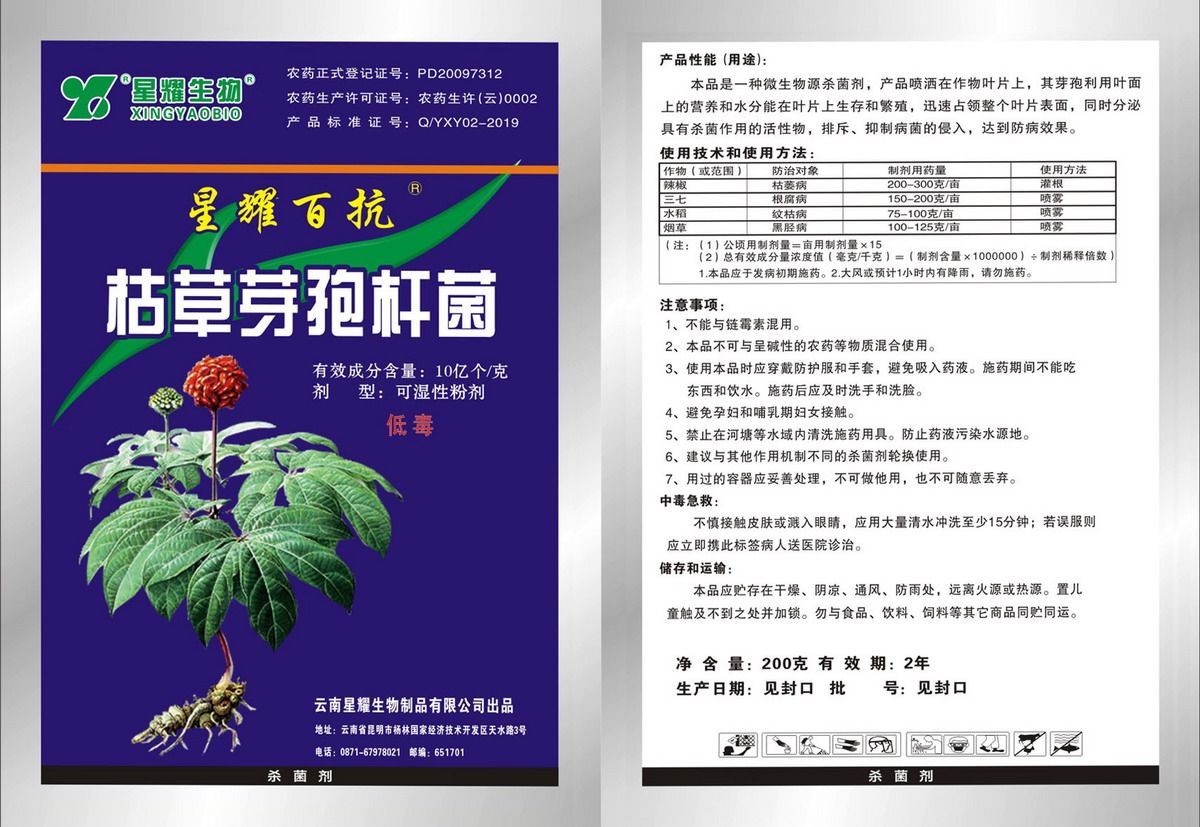This product is a broad-spectrum agricultural microbial fungicide, through the effective component of Bacillus subtilis sprayed on crop leaves, its spores can survive and reproduce on the leaves using nutrients and water on the page, quickly occupying the entire leaf surface, simultaneously Secretes has the bactericidal effect the active material, the rejection, the inhibition pathogen's invasion, achieves the disease prevention effect.
APPLICABLE CROPS: All kinds of organic vegetables, melons, medicinal materials, tobacco, fruits, flowers, lawns and other control
objects: Fusarium wilt, root rot, black Shank, sheath blight and other fungal root and leaf diseases.
Fusari M Solani (Mart.) SACC. F. Sp. . Radicicola (WRR) snyd. . & HSS. It's called Fusarium Solani, and it's a Fungi IMPERFECTI fungus. On PSA, the aerial mycelium is more developed, the mycelium has striate, dense thick, gray-white, the reverse side of late culture dish turns blue-green. Microspores are produced early and often; solitary on a small pedicel, variously shaped, mostly curving-ovoid. The megaspore is produced on the multi-branched Conidia Pedicel, the sporogenous cells are bottle-shaped, the Megaspore is unequal-sided spindle-shaped, slightly curving, wider and shorter, 2 -- 4 Septations, most of which are 3 septations, and the Basal podocytes are not obvious; The second cell of Basal part was the widest, and the APICAL cell was slightly beaked. 3 septate Megaspore 26-405-6(m) .
Because Panax Notoginseng likes warm and damp, its unique ecological environment is easy to induce various diseases. Among them, plant chlorosis and fusarium root rot is one of the most important soil-borne diseases which restrict the development of Panax Notoginseng. The root rot of Panax Notoginseng is of two types: Wet Rot and dry rot. The root rot of Panax Notoginseng is serious in high temperature and wet season from May to August every year. The above-ground part of the leaf color is not right, the leaf wilts, yellowing off, the underground part of rot. Continuous cropping was more serious than rotation and new cropping, and the longer the duration of continuous cropping, the more serious the disease.
The way of transmission and the condition of disease occurrence: the disease is easily induced by overwintering bacteria in seeds, seedlings, diseased soil and diseased remains. Especially after transplanting of Panax Notoginseng, the root is dry and soft, the soil is saturated with water, the root hair is easy to suffocate and die, and the pathogen is easy to get sick. In April and May, the temperature rose, the disease stopped, the temperature was high and rainy in June and September, and the peak period of the disease was reached. The disease is also related to excessive water loss or heat during the transportation of seedlings. Field soil is too sticky, plant growth is poor, resulting in root tissue disease resistance is not strong susceptible to disease.
Application Technique and method:
1. Spray the surface before emergence and the seedling after emergence: 10 billion gram per gram of Bacillus subtilis 50 grams mixed with 30 catties of water.
2. Dip Root before transplanting: 10 billion BCG BACILLUS SUBTILIS 50 g water 30 Jin dip root.
3. Irrigation after transplanting: Xingyaobaikang 10 billion grams of Bacillus subtilis 200 grams per mu 600 times liquid irrigation root.
4. PREMORBID use: Xingyaobaikang 10 billion / Gram Bacillus subtilis 200 grams / mu 600 times liquid irrigation root.
Note:
1, the wind or rain is expected within
1 hour, please do not apply;
2, not with strong acid, strong alkaline pesticides mixed application;
3, to avoid eating, misuse, after application wash hands wash face.





